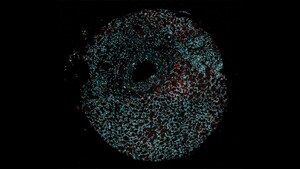Scientists show how brain circuit generates anxiety
COLD SPRING HARBOR, N.Y., May 29, 2018 /PRNewswire/ -- Neuroscientists at Cold Spring Harbor Laboratory (CSHL) have identified a neural circuit in the amygdala, the brain's seat of emotion processing, that gives rise to anxiety. Their insight has revealed the critical role of a molecule called dynorphin, which could serve as a target for treatment of anxiety-related disorders including post-traumatic stress disorder (PTSD).
Very intense fearful experiences, especially those that are life threatening, are often "over-learned" and can lead to an unhealthy level of anxiety or to anxiety disorders, which affect about 18% of the adult US population.
Previous studies indicate that two regions in the amygdala, the central amygdala and the BNST, coordinate short-term and long-term responses to various kinds of threatening stimuli. "What we haven't known are the underlying circuit and cellular mechanisms in these regions that control the generation of anxiety," says CSHL Professor Bo Li, who led the research.
The central amygdala forges strong inhibitory connections with the BNST. To learn about what happens to these connections during anxiety, his team genetically manipulated one specific type of neuron called SOM+ because of a peptide they express called somatostatin. Li's prior work showed that these "SOM+" neurons are necessary for the learning of fear responses. The team traced the mechanism behind this anxiety within a circuit that runs between the central amygdala and the BNST.
The process leading to anxiety began with increased excitation of SOM+ neurons in the central amygdala. This led to a large increase in signaling by dynorphin, a peptide made by these neurons. This aberrant signaling interfered with normal inhibition of SOM+ neurons in the BNST and resulted in their becoming overactive. The net result was a display of anxious behavior.
Dynorphin signaling was in this way identified as the driver of elevated anxiety. The team was able to ameliorate anxiety by manipulating the newly identified circuit. "That's why we think this is an important circuit in anxiety," says Li.
Li states: "Our results suggest that dynorphin can drive anxiety and therefore could be a cellular target for treating increased anxiety induced by stress. Our next step is to understand whether the receptors for dynorphin are expressed in the SOM+ neurons in the central amygdala itself or if they're expressed by some other inputs onto the BNST."
Funding: National Institutes of Health; NARSAD/Brain and Behavior Research Foundation; Louis Feil Trust; Stanley Family Foundation; Simons Foundation; Human Frontier Science Program; Wodecroft Foundation; CSHL and Northwell Health Affiliation; CSHL Cancer Center Support Grant.
About Cold Spring Harbor Laboratory
Founded in 1890, Cold Spring Harbor Laboratory has shaped contemporary biomedical research and education with programs in cancer, neuroscience, plant biology and quantitative biology. Home to eight Nobel Prize winners, the private, not-for-profit Laboratory employs 1,100 people including 600 scientists, students and technicians. For more information, visit www.cshl.edu
SOURCE Cold Spring Harbor Laboratory
Related Links
WANT YOUR COMPANY'S NEWS FEATURED ON PRNEWSWIRE.COM?
Newsrooms &
Influencers
Digital Media
Outlets
Journalists
Opted In






Share this article